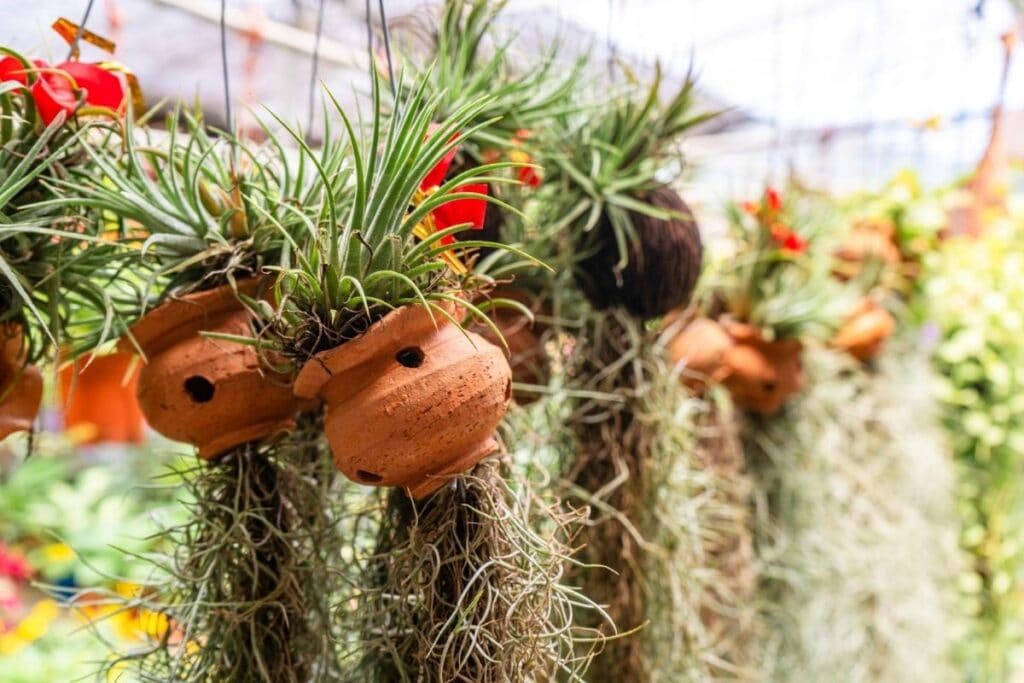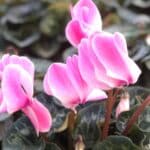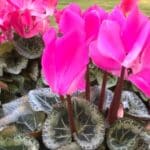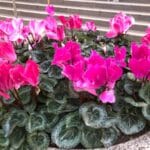Air plants are some of the most fascinating and unique plants that you can grow in indoor spaces. These plants can bravely go where no other plants will survive, all while looking great and adding charm to your environment. Read this article to learn what these plants are, what makes them so special, and just how you can grow them in your home.
What Are Air Plants?
From the Greek words epi or ‘upon’ and phyto meaning ‘plant’, the term epiphyte refers to plants that anchor themselves and grow on another plant or other inanimate material. They are not parasitic, only using the host plant to reach locations where there’s adequate exposure to light, rainwater, and air for their own growth (1).
Air plants grow without needing a substrate or soil to provide the nutrients and moisture they need. They generally draw these necessities from the air instead. There are many kinds of air plants ranging from orchids, ferns, mosses, and algae (1).
A big group of epiphytes belongs to the Bromeliaceae family, known as the genus Tillandsia and the term ‘air plants’ is commonly used to refer to this group by growers.
The largest member of the bromeliads, Tillandsia houses over 700 plant species and varieties, most of them found in Latin America (2). They do not just grow on trees but on rocks, cliffs, driftwoods, and other sturdy plants too.

Tillandsias are literally foliage plants, relying heavily on their leaves to absorb water and nutrients from the air (1). Their stiff, often wiry leaves have special fuzzy scales called trichomes which allow the plant to harness moisture and food in their surroundings (3).
Tillandsias are slow-growing but when they bloom, they produce some of the best flowers. Exposure to maximum allowable light, water, and fertilizer encourages blooming for these plants (1).
Although the colors of the bloom may be largely associated with the specialized leaves called bracts, their flowers can be fancy and draw attention to the plant even more. Some air plants have aromatic and elegant flowers like T. cyanea, T. caerulea, and T. stretocarpa while others can have insignificant blooms like T. usneoides (1). All these flowers may last for several weeks, even up to months, and only occur once in the lifetime of an air plant. Often after flowering, new plants will form at the base or along the stem of the old plant (3).
Plant Facts
| Scientific name | Tillandsia spp. |
| Common names | Air plants |
| Family | Bromeliaceae |
| Plant Type | Houseplant, epiphyte |
| Height and Width | 2 inches to several feet (Depending on species/cultivar/variety) |
| Origin | Variety of habitats in North, Central, and South America |
| Flower colors | Red, yellow, pink, purple |
| Foliage color | Green, gray-green, silver, pink |
| Sun Exposure | Bright indirect light |
| Soil Type & pH | Does not require soil |
| Special features | Epiphyte |
How to Grow Air Plants
Air plants are very easy to grow once you understand that they are epiphytes that do not need soil. Their propagation and pruning techniques are pretty straightforward, only their potting (or lack thereof) needs careful consideration.
Popular ways of displaying air plants indoors are by hanging them on decorative wires or placing them in glass containers. There are numerous types of air plant containers and holders you can choose.
Different air plant species exhibiting a variation of leaf formation can be installed on varnished driftwoods. Tillandsias are also charming companions to plants like orchids, adenium, and other bromeliads.
Propagation
Tillandsias can produce clump-forming pups all year round as soon as they’ve reached maturity (2). This may take some time, even years, considering air plants are slow-growing. But these pups can be separated to grow into individual plants too.
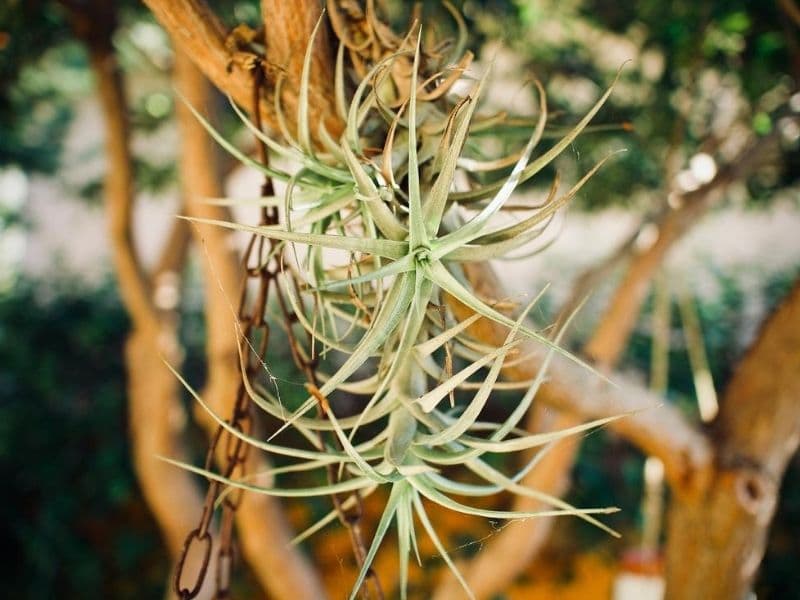
In the wild, Tillandsias can live for many years and with the right care, indoors too! However, after flowering, the plant will ultimately decline but not without leaving some offsets. 2-8 new plants called pups will form around the parent as it shrinks, giving way to the new growth cycle (1).
The pup needs to be one-third of the size of the parent before breaking off to ensure that it will be able to survive on its own. The mother plant provides the nutrient reserve for the attached offset so once separated, the pup will require more care than an established air plant (1).
A healthy tillandsia will normally not want any more than the regular misting and light exposure but fertilizer application once a month through foliar spray will help keep the leaves lush and may hasten its flowering (3)
Soil
Unlike normal plants, the shallow roots system of air plants is only used to anchor them to their host so soil is unnecessary. When grown indoors, they can be suspended in the air or installed on surfaces using glue, wire, or string and be left to fend for themselves as is.
Pruning
Air plants can be pruned for neatness although this is often unnecessary. Old, dry leaves can simply be torn off carefully by hand or cut off. Partially dead leaves should be removed, although dry, brown leaf tips can be trimmed off.
When your plant develops pups, it will be beneficial to clear some space around the young plantlets as they grow. Leaves overhanging the pups can be cut back if necessary. Old flowers can also be removed with a sharp cutting tool.
Always sterilize your cutting tool before pruning to avoid spreading infections between plants.
Repotting and Transplanting
Air plants do not need to be repotted and can be moved around with ease. They can survive temporarily in low light conditions, but should not be exposed to extreme temperatures or harsh sunlight.
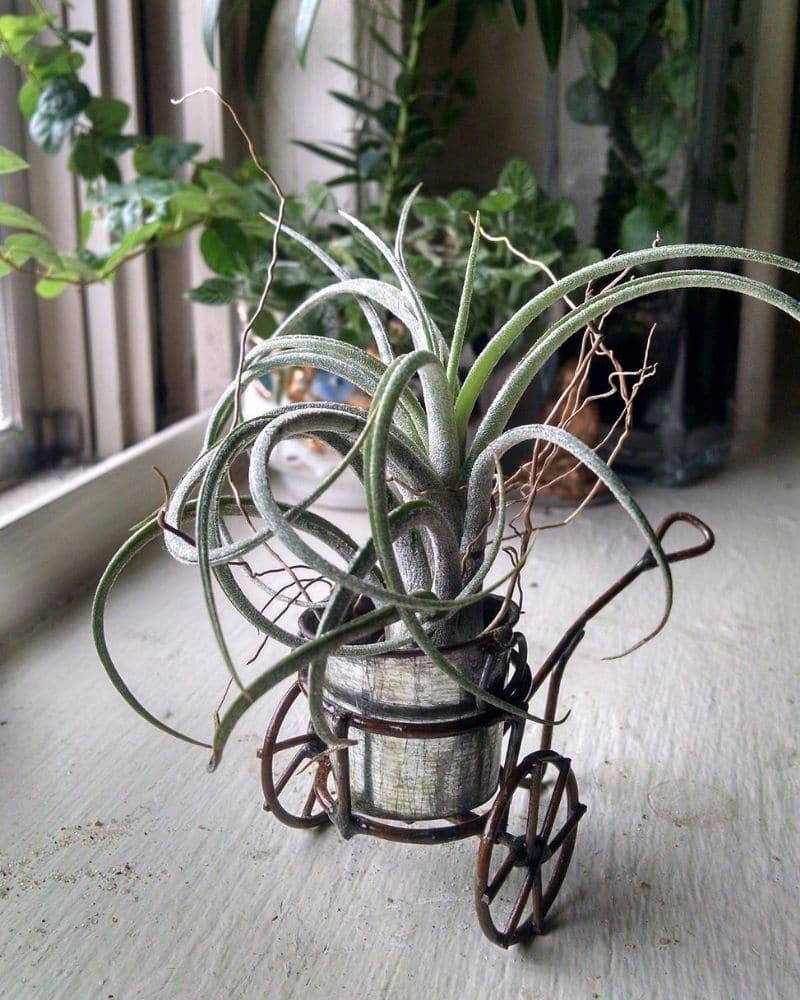
How to Care for Air Plants
Tillandsia species are generally hardy plants that are very easy to care for and require little maintenance. They are living plants, of course, so they do require light, moisture, air, and nutrients to survive. Read on to learn how to keep your air plants alive and growing.
Water
Air plants have unique water requirements. They absorb moisture and nutrients through air plant leaves rather than roots, making them low-maintenance. To water air plants, mist them thoroughly with room temperature water 2-3 times a week, ensuring the entire plant is moistened.
Alternatively, you can soak them in room temperature water for 20-30 minutes once a week, then shake off excess water and allow them to dry upside down to prevent rot.
In hot or dry conditions, increase watering air plants frequency slightly, but avoid overwatering as it can lead to rot. Proper hydration is key to keeping air plants healthy and vibrant.
Sunlight
Air plants thrive in bright, indirect sunlight. They prefer filtered natural light, such as that provided by a sheer curtain or placed near a window with a sheer covering. Direct sunlight, especially intense afternoon sun, can scorch the leaves of air plants, so it’s best to avoid prolonged exposure to harsh sunlight.
In indoor settings, placing them within a few feet of a window where they can receive ample ambient light is ideal. Outdoors, a shaded or partially shaded area with bright, indirect light is preferable for the health and vitality of air plants.
See more: How much light do air plants need?
Humidity and Temperature Air Plants
Air plants like good air circulation. Depending on the species, they may prefer humid or dry conditions. Avoid growing them in a sealed container with high humidity and no airflow as they will certainly rot.
They like to be kept cool during summer and warm enough during winter. The optimum temperature for these epiphytes ranges from 7 to 35 ̊C and they should never be kept wet or moist.
Fertilizer
To encourage your house plants to produce flowers, fertilize them with a one-quarter to one-half-strength liquid fertilizer each month. Special Tillandsia fertilizer products are available, which can be applied as a mist on the foliage.
When growth slows and demand for nutrients decreases in the winter, fertilizing can be limited to a dose every second month.
Pest and diseases
One advantage of growing air plants indoors is their resilience to pest attacks. Although they may have the occasional mealybugs and scale insects, they can be easily spotted and removed manually or by insecticidal spray.
The key is to always do spot checks on your plants, especially if they are docked on a piece of driftwood or another plant that might be carrying the pest or disease. If there’s any indication of pests, they should be isolated away from other indoor plants and treated immediately.
Rotting is the most frequent problem associated with air plants but this is often related to watering practices and extreme cold conditions. As long as the Tillandsia is allowed to dry out between watering, decay and possible pathogenic attacks will be avoided. Any plant that has suffered cold damage can rarely be saved (2).
Brown leaf tips are a common indication of too much sunlight exposure, a lack of water, or both. Plants that are too dry will have leaves that roll closed. They can be rehydrated by submerging in bottled water for several hours.
Common Varieties and Cultivars
There are over 600 different species in the Tillandsia genus and many varieties and cultivars are available too. A great number of these interesting plants are grown in homes, commercial spaces, and private collections all over the world.
The following species are just a few of the better known and more easily available types of air plants that you can grow:
- T. cyanea – pink quill
- T. duratii
- T. harrisi
- T. ionantha – sky plant
- T. pseudobaileyi
- T. rothii
- T. tectorum
- T. usneoides – Spanish moss
FAQs
How do you take care of an air plant indoors?
To care for an air plant indoors, soak it in water for 20-30 minutes once a week, then allow it to dry completely in a well-ventilated area. Provide bright, indirect light, and ensure good air circulation around the plant.
Do air plants need full sun?
While air plants can tolerate some direct sunlight, they generally prefer bright, indirect light. Too much direct sunlight can cause their leaves to burn or dry out.
Can you overwater an air plant?
Yes, you can overwater an air plant. It’s essential to allow the plant to dry completely between waterings to prevent root rot. If the plant’s base remains wet for prolonged periods, it may develop rot or mold.
How do I know if my air plant is happy?
A happy air plant will exhibit vibrant green leaves that are firm and upright. It may produce new growth, such as pups or flowers, indicating good health. Additionally, the plant will absorb water readily during its soaking sessions and dry out within a few hours after watering.
Conclusion
As one of the easy to care for houseplants, air plants offer a fascinating alternative to the regular potted houseplant. All these survivors really need is abundant indirect light, and regular access to moisture to thrive. When you think about it, there are so many places in the home that you could place a Tillandsia that there’s no excuse not to start growing these stylish and hardy bromeliads!
See more: Plants that grow on other plants
References
Reference List
(1) Sengo, Z. “Air Plants: The Curious World of Tillandsias”. 2014. P. 224.
(2) Lesseig, R. & Lesseig M. “Air Plant Care and Design: Tips and Creative Ideas for the World’s Easiest Plants”. 2016. Simon and Schuster. P. 176.
(3) Hiang, S. “Exotic Tillandsia”. 2014. Partridge Publishing Singapore. P. 162.
Close
Image by Kukota/depositphotos

